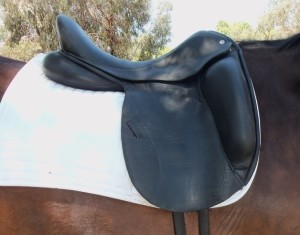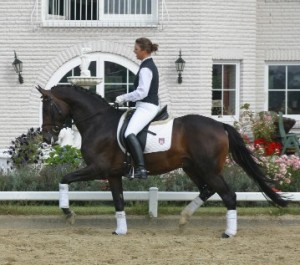My job as an equestrian fitness trainer is to do more than just make a rider more physically fit. It’s also to make the rider’s body more balanced, more stable, more mobile, and more athletic. To understand exactly what that means, read last week’s post. This week’s post is all about what happens when the rider’s body reaches that state where the neuro-muscular pathways have been created or re-connected, and the rider’s body is now in a state that it*naturally* wants to stay in a balanced position… only to find that the saddle is interfering with that naturally balanced position.

This saddle creates a “channel” for the rider’s leg with large thigh blocks, but sits the rider behind the horse’s center of balance, removing the rider’s ability to adapt to changes in longitudinal balance along with the horse.
Let’s take a step back and talk about saddles… dressage saddles, specifically. Other types of saddles have their own issues that we can talk about in another blog, but Dressage saddles have traditionally been designed to allow a rider to sit comfortably, in a relaxed and perfectly balanced position, and move freely with the horse. Their seats used to be somewhat flat, knee rolls and thigh blocks virtually nonexistent, and flaps were angled slightly in such a way that the rider’s back could relax into a neutral position without tension on the lumbar spin or the hip flexor, without sliding over the front of the flap.
With the influx of amateur riders into the Dressage sport over the past 50 years, it became clear that without a natural (or trained) balance for riding, riders were struggling to keep their legs in place and keep their seats in the saddles, and so saddle companies started making the seats deeper and deeper, to help stabilize the riders’ pelvis. Then thigh blocks came into the picture, to help secure the rider’s leg so it didn’t slip around quite so much. Then, even blocks at the back of the thigh were added to further prevent the rider’s leg from slipping out of position. Amateur riders around the world have hailed this as an advancement in saddle fit, and love the secure feeling they can get from these saddles. Until they meet me…
We previously talked about what it means to be a fit rider, and so keeping in mind that we are talking about creating that “natural” balance in a rider that has previously not had it, guess what happens when their bodies have started to make that adaptation, become more capable of sitting on a moving object in relaxation and with greater self-stability and tremendously greater mobility, and then are put up into a saddle that is intended to restrict that mobility. Suddenly, the saddle is the restriction keeping the rider from balancing naturally with their horse.
The unfortunate reality is that these large thigh blocks are often coupled with a saddle that is fitted behind the horse’s shoulder in such a way that the deepest part of the seat is behind the horse’s center of balance, making it impossible for the rider to ever sit in balance with the horse, and if they manage to sit in balance with gravity, their legs are back about mid-ribs on the horse, not “at the girth” where the horse is naturally narrower, and which the legs will always attempt to migrate back to (causing a chair seat). So, the catch-22 for these riders is to either ride in actual balance, fighting the saddle, or ride in the balance the saddle sets them up for and never be properly balanced.
It is exciting to be able to help riders find a natural neurological balance when they have never felt that before on a horse! And, equally distressing to help a rider make such amazing changes in their body only to have to tell them, “Well, you are going to have to put your leg in an incorrect position in order to maintain your balance in this saddle.” or, “Unfortunately, you are not going to be able to balance in the way your body has now become capable of, in this saddle, because the thigh blocks are preventing you from finding the correct alignment.”
Saddle buying can become a nightmare, with the saddle fitting both the horse AND the rider becoming  an elusive mirage when saddle after saddle doesn’t fit quite right. But, as much as it is a dreaded thing to look for yet another saddle, I encourage riders to consider your saddle choice very carefully. If your goals include becoming a more skilled rider, look for saddles that will allow your body to develop, not just the saddle that makes you feel comfortable and secure right now.
an elusive mirage when saddle after saddle doesn’t fit quite right. But, as much as it is a dreaded thing to look for yet another saddle, I encourage riders to consider your saddle choice very carefully. If your goals include becoming a more skilled rider, look for saddles that will allow your body to develop, not just the saddle that makes you feel comfortable and secure right now.
Stay away from the saddle that makes you feel like you’re sitting on your pubic bone, because that one will ultimately prevent you from riding in that relaxed, tension-free position. Especially avoid the saddle that “locks” your leg into position, because that one will prevent you from developing proper neuro-muscular control of your body. A really good idea might be to do some Ridefit mobility and stability exercises BEFORE you sit in a potential saddle, so that your body is optimally balanced and you can truly feel what the saddle is going to do for you or against you. It only takes about 15 minutes if you use our Rider Warmup video.
You CAN ride better, and a properly designed saddle will allow that to happen much more easily!
Speak Your Mind